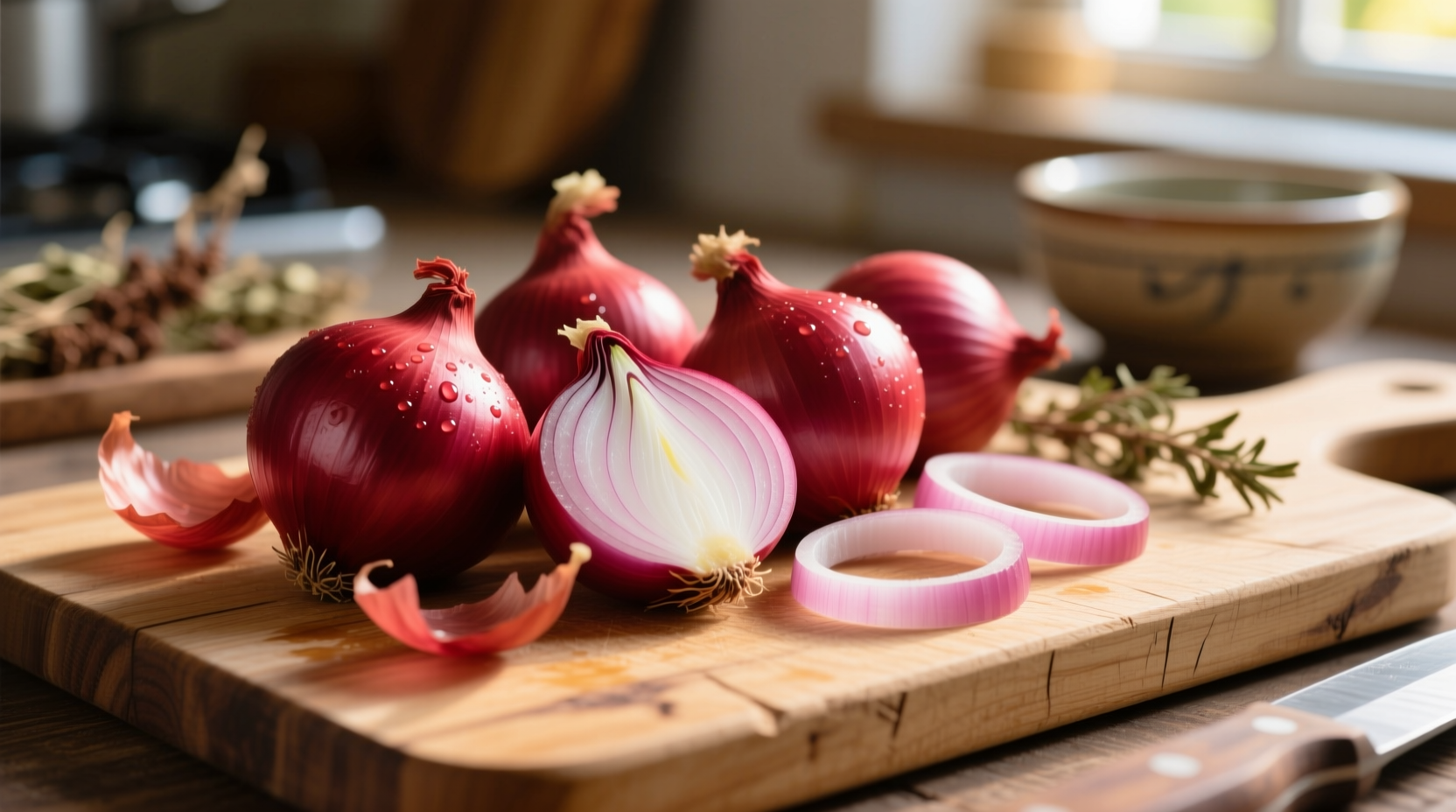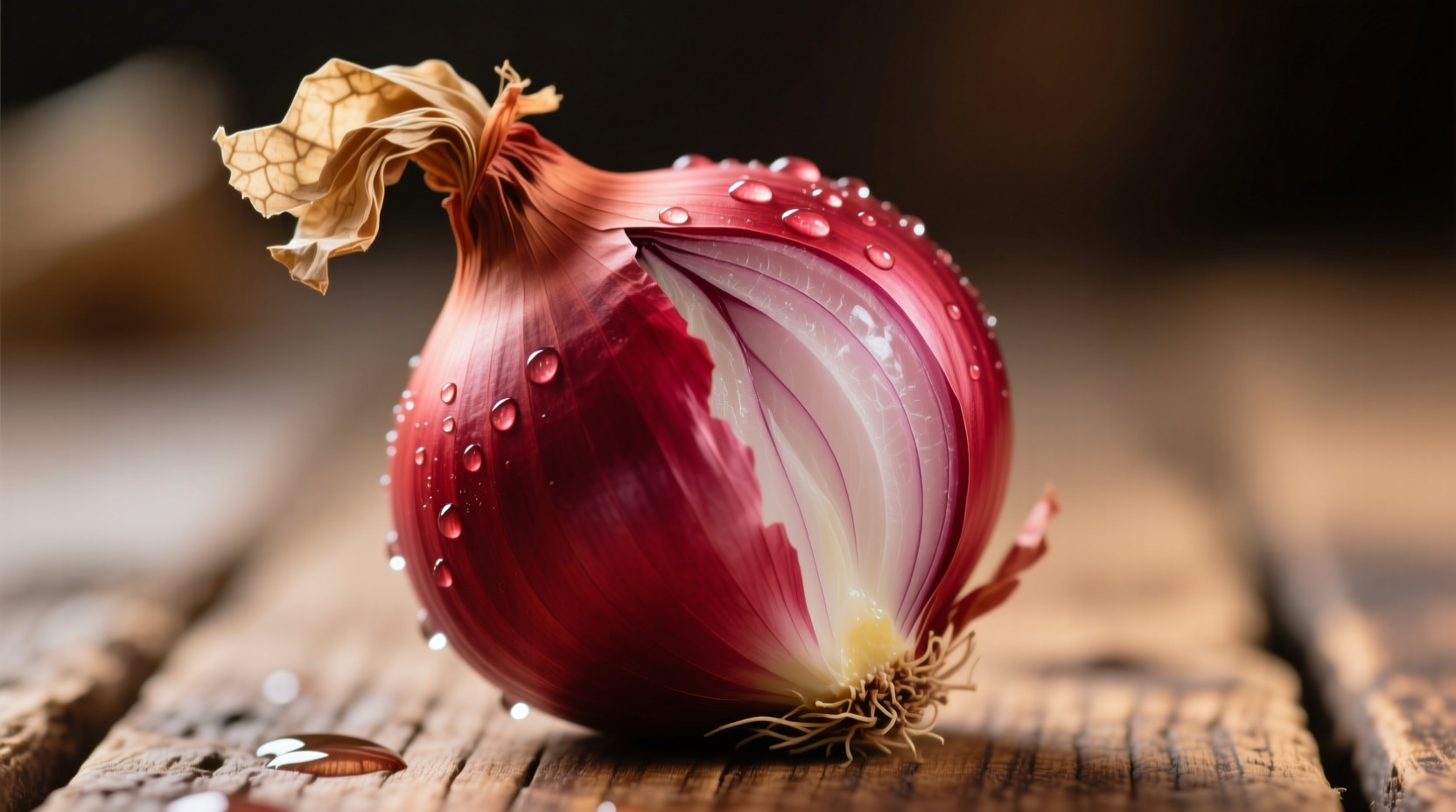A medium red onion (110g) contains approximately 44 calories, with 10g of carbohydrates, 2g of fiber, and zero fat. This vibrant vegetable offers significant nutritional benefits while remaining exceptionally low-calorie, making it ideal for health-conscious cooking and weight management diets.
Discover exactly what makes red onions a nutritional powerhouse in your kitchen. Whether you're tracking calories for weight management, seeking antioxidant-rich ingredients, or simply curious about how this colorful vegetable compares to other onion varieties, you'll find precise, science-backed information to inform your dietary choices.
What Makes Red Onions Nutritionally Unique
Red onions (Allium cepa) stand out from their white and yellow counterparts with their distinctive purple hue and slightly milder flavor profile. This visual difference isn't just cosmetic—it signals a higher concentration of beneficial compounds that contribute to their impressive nutritional profile.
The vibrant color comes from anthocyanins, powerful antioxidants also found in blueberries and red cabbage. These compounds not only give red onions their characteristic color but also provide significant health benefits that extend beyond basic nutrition.

Complete Red Onion Nutritional Profile
Understanding the complete nutritional composition helps you make informed dietary decisions. Here's the detailed breakdown per 100g serving of raw red onion, according to the USDA FoodData Central database:
| Nutrient | Amount | % Daily Value* |
|---|---|---|
| Calories | 40 kcal | 2% |
| Total Carbohydrate | 9.3g | 3% |
| Dietary Fiber | 1.7g | 6% |
| Sugar | 4.2g | - |
| Protein | 1.1g | 2% |
| Vitamin C | 7.4mg | 8% |
| Vitamin B6 | 0.12mg | 7% |
| Folate | 19μg | 5% |
| Potassium | 146mg | 3% |
| Calcium | 23mg | 2% |
| Magnesium | 10mg | 2% |
*Percent Daily Values are based on a 2,000 calorie diet. Your daily values may be higher or lower depending on your calorie needs.
Red Onion vs. Other Varieties: Nutritional Comparison
While all onions share similar nutritional foundations, subtle differences can impact your dietary choices. This comparison helps you select the right onion for your nutritional goals:
| Nutrient (per 100g) | Red Onion | Yellow Onion | White Onion |
|---|---|---|---|
| Calories | 40 | 42 | 43 |
| Carbohydrates | 9.3g | 9.8g | 10.0g |
| Fiber | 1.7g | 1.4g | 1.3g |
| Vitamin C | 7.4mg | 5.8mg | 5.5mg |
| Quercetin | High | Moderate | Low |
| Anthocyanins | High | None | None |
Research published in the Journal of Agricultural and Food Chemistry confirms that red onions contain significantly higher levels of quercetin and anthocyanins compared to other onion varieties. These antioxidants contribute to red onions' superior free radical-scavenging capacity, making them particularly valuable for long-term health maintenance.
Health Benefits Backed by Science
The nutritional profile of red onions translates to tangible health benefits supported by scientific research:
Cardiovascular Support
The combination of quercetin, sulfur compounds, and anthocyanins in red onions may help maintain healthy blood pressure levels and improve cholesterol profiles. A 2021 study in Nutrients found that regular onion consumption was associated with improved endothelial function, a key factor in cardiovascular health.
Blood Sugar Management
Despite containing natural sugars, red onions have a low glycemic index (approximately 10) and contain compounds that may help regulate blood sugar. Research from the University of Guelph demonstrated that onion extracts could stimulate insulin production and improve glucose metabolism.
Antioxidant Protection
Red onions rank exceptionally high on the Oxygen Radical Absorbance Capacity (ORAC) scale, measuring antioxidant capacity. Their anthocyanin content provides protection against oxidative stress, potentially reducing the risk of chronic diseases. According to USDA data, red onions have approximately 2.5 times the antioxidant capacity of yellow onions.
Practical Ways to Maximize Nutritional Benefits
How you prepare and consume red onions significantly impacts their nutritional value. These evidence-based techniques help you get the most from this versatile vegetable:
Raw Consumption for Maximum Benefit
Eating red onions raw preserves their full antioxidant profile. Cooking can reduce certain heat-sensitive compounds, though it enhances others. For maximum quercetin absorption, slice onions and let them sit for 5-10 minutes before eating to allow beneficial compounds to fully develop.
Pairing for Enhanced Absorption
Combine red onions with healthy fats like olive oil or avocado to improve absorption of fat-soluble antioxidants. The vitamin C in red onions also enhances iron absorption from plant-based foods like spinach and lentils when eaten together.
Storage Techniques That Preserve Nutrients
Store whole red onions in a cool, dark, well-ventilated place (not the refrigerator) for up to 2-3 months. Once cut, store in an airtight container in the refrigerator for 7-10 days. Avoid storing near potatoes, which release gases that accelerate onion spoilage.
Contextual Considerations for Different Dietary Needs
While red onions offer numerous benefits, certain dietary contexts require special consideration:
For individuals following a low-FODMAP diet to manage IBS symptoms, red onions contain fructans that may trigger digestive discomfort. The Monash University Low FODMAP app recommends limiting red onion intake to 38g (about 1/4 medium onion) per serving to minimize potential issues.
Those on blood-thinning medications should maintain consistent onion consumption rather than dramatic fluctuations, as the vitamin K content (though relatively low) could potentially interact with medication efficacy when consumed in very large quantities.
Simple Ways to Incorporate Red Onions Into Your Daily Diet
Transform your meals with these practical, nutrition-focused applications:
- Add thinly sliced raw red onions to salads for crunch and color (let sit 10 minutes to reduce sharpness)
- Create quick pickled red onions by soaking slices in vinegar, water, and a pinch of sugar for 30 minutes
- Blend raw red onion into homemade salad dressings for subtle flavor without overpowering bite
- Add to fresh salsas for vibrant color and mild heat
- Use as a colorful garnish for tacos, grilled meats, or fish dishes
- Include in vegetable stir-fries during the last 2-3 minutes of cooking to preserve nutrients
Remember that even small amounts of red onion can significantly boost the nutritional profile of your meals. Just 28g (about 1/4 cup) adds only 11 calories while contributing valuable antioxidants and fiber to your diet.











 浙公网安备
33010002000092号
浙公网安备
33010002000092号 浙B2-20120091-4
浙B2-20120091-4